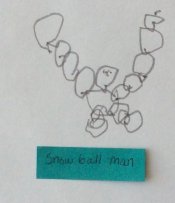Christopher, PreK
Year 1, Cohort 1, Non-Rural Alaska
Child-Nature Points of Interest (2018-2019)
Demographic Information
- Ethnicity: White/Caucasian, Indian
- DOB: February, 2014
- Gender: Male
- Birthplace: Wasilla, AK
- Family Members: Mother, Sister (age 6)
- Years Parent Lived in Alaska: 37
- Parent’s feeling about place lived: 10 (1-10 rating; 10=extremely happy, 1=extremely unhappy)
- House Location(s) in Fairbanks: Inside Fairbanks City Limits
Source: Family Survey, Fall 2018 (completed by Christopher’s mother)
- Family Outdoor Activities:
(Ranked frequently and almost always)- Go to playground or park (in city/town/village)
- Go on walks (in city/town/village)
- Child’s Outdoor Activities:
- (Ranked frequently and almost always)
- Bike, scooter, or skate
- Make-believe/free play (outdoors summer)
- Pick flowers
- Look for bugs
- Hide and seek
- Play with dog
- Jump on trampoline
- Collect/Find things (rocks/leaves)
- Favorite Family Activity (Written response): "Anything 'summer-y' (water guns, pools, etc."
- Child’s Favorite Summer Activity (Written response): “Riding bike"
- Child’s Favorite Winter Activity (Written response): “Still getting interested in winter"
- Description of outdoor experience when child was afraid/scared (Written response): “None"
- Description of outdoor experience when child was excited/happy (Written response): “He likes robots/transformers and I had a ladybug on my finger. I told him the bug was going to lift his 'shields' and fly away, and when it did, Christopher was mesmerized."
Source: Family Survey, Fall 2018 (completed by Christopher’s mother)
Child's Drawings

Title: Playing hide and seek
Child quotes:
“I play games like hide and seek.”
“My sister”
“She hides in a mystery spot”
“We play it at our house.”
“I feel like I’m with my mom when I play hide and seek.”
“Under the slide”
“I don’t draw mosquitoes in my picture…they sting, just giving me tons of mosquito bites…and I just try to squish them…and they sneaky to fly so fast.”
Family Feedback:
Christopher’s mother writes that he plays hide and seek “when playing outside (or even inside the house) when friends come over.” She writes that he plays with “his sister or neighbor friends…in the neighborhood, playground, in/around the house.” She writes, “Since he learned it [hide and seek] this summer, he plays whenever he has a chance and friend! He loves finding small hiding places and the anticipation of being found.”

Spring 2019
Title: Make a snowball guy
Child quotes:
“Make a snow ball guy.”
“All the time”
“At recess”
“With no one”

Spring 2019: No drawing

Child Quotes:
“It was just like big monster, and I killed it.”
“That was, that was in the woods and it was chasing me.”
“He was like, he was so slow. I just punched him.”
Spring 2019: No Drawing
Fall 2018
Class Nature Tour Video Highlights
Emotional and Behavioral Points of Interest:
Expressed anxiety about going into trees and bushes “I don’t want to go in there”; Difficult time navigating logs off trail (falls)
Fall 2018
Family Nature Tour Highlights
Emotional and Behavioral Points of Interest:
Desired to stay inside versus going outside; Stayed on bike on paved road/ limited interaction with environmental features; Used Imagination to transform environmental features - influenced by media/ video games (i.e., Spider Beedrill); Made aggressive comments towards other living beings (birds) and imaginary creatures
Spring 2019
Class Nature Tour Highlights
Emotional and Behavioral Points of Interest:
Sitting out on bench- desire to leave; pushed off tree; interest in small animal (on sign)
Child Reflections on Educational Activities
Child's Quote:
“His name is Mark.”
Child's Quotes:
“I saw a den with a wolf; it was like starring at me.”
“Cool.” (Comment on stick play)
“It [the snow] was like too cold.”
“Can go on the bridge. Can’t go in the forest.”
“I learned there was weasels that lived in the ground.”
This project is funded by the National Science Foundation. Award # 1753399, CAREER: A longitudinal study of the emotional and behavioral processes of Environmental Identity Development among rural and non-rural Alaskan children

